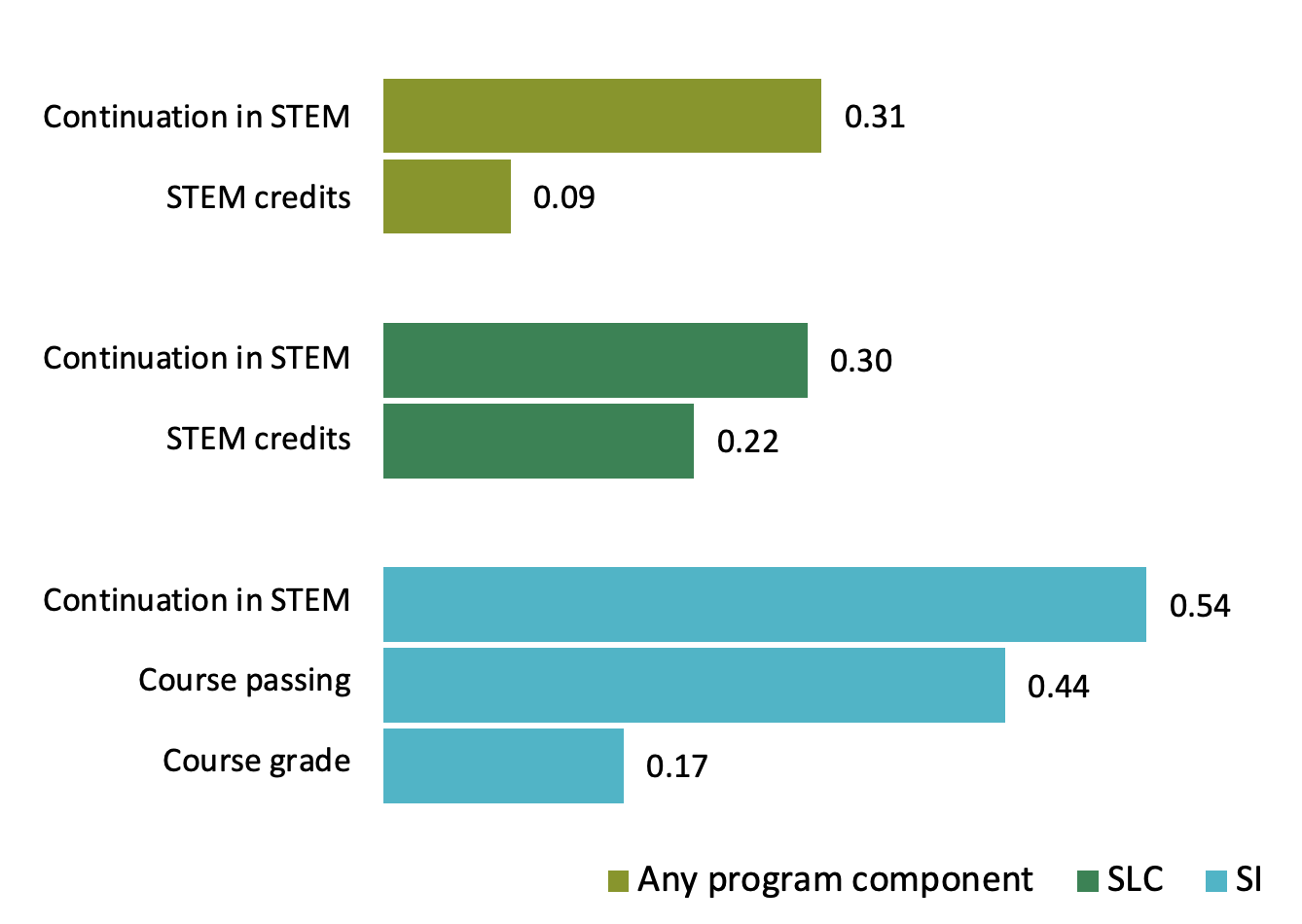
By Victoria Sosina and Allison Milby
March 1, 2022
Addressing underrepresentation in STEM
Although nationally Latinx students declare majors in science, technology, engineering, and math (STEM) fields at similar rates as White students, our postsecondary education systems lose Latinx students along the way, resulting in disproportionately fewer Latinx STEM majors and degree holders.1 Community college students face a variety of institutional barriers to success in college that result in low course completion, extended time to degree completion, and low STEM transfer rates.2 To address these challenges, Los Angeles City College (LACC) launched the STEM Pathways (STEMP) program in 2016 to reduce systemic barriers, create new opportunities, and consequently improve STEM persistence and completion for low-income and Latinx students.3
How the STEM Pathways program addressed the challenge
The STEMP program offered a variety of supports for students including access to peer tutoring via Supplemental Instruction (SI) and the STEM Learning Center (SLC), a book and technology loan program, specialized support from a STEM counselor, and an undergraduate research program. Although the STEMP program focused on supporting low-income and Latinx students, most components were open to all students. To participate in the undergraduate research program and the book and technology loan program, a student needed to have declared a STEM major and met a minimum GPA among other requirements.
To examine how well the program reached the desired student populations, SRI compared Latinx and low-income student representation in the program to their representation in the overall STEM student population between fall 2017 and fall 2019. If the STEMP program was successful in reaching its desired student populations, we would expect the program to have a higher percentage of Latinx and low-income students than the overall STEM population. Although student participation varied by term, about half of program participants identified as Latinx, and more than two-thirds received financial assistance. Comparing the numbers of the program’s low-income and Latinx student population rates to the LACC STEM student population, we found that the program was successful at proportionally serving low-income students but could improve its outreach to Latinx students.
Promising Impacts on student success
Improved outreach to Latinx students is particularly critical because students who participated in the STEMP program had improved academic outcomes. To estimate the impact of the program on student performance and attainment, SRI examined outcomes for students who participated in any program component4 and for those who participated in each of the two most popular components: SI and the SLC. We compared STEMP program students to similar STEM students not participating in the program, in each term between fall 2017 and fall 2019. We then combined term-specific estimates to obtain an average program effect during the study period.5
The STEMP program yielded encouraging results. We found positive average effects for multiple program components and outcomes after controlling for student race/ethnicity and income:
- Students who participated in any program component and in the SLC obtained more STEM credits and were more likely to continue in STEM than STEM students who did not participate.
- Students who participated in SI had higher grades in the course that offered SI support, were more likely to pass that course, and were more likely to continue in STEM than similar peers enrolled in the same courses.
Statistically significant average effect sizes for students across terms by program component and outcomes, fall 2017 to fall 2019

Note: Effect size of .20 to .80 is considered medium in magnitude, and less than .20 is considered small.
The STEMP program was successful in reaching low-income students, and our analysis suggests that it improved STEM outcomes for participating students. These findings are consistent with a large body of research on student development in college that suggests that targeted academic and peer supports are effective in improving student learning, progression, and completion of their educational goals, particularly for students who are historically marginalized. 6
Considerations
The evaluation results reinforce existing evidence showing that programs offering student-centered supports can positively impact course success and degree completion.
Implementing innovations at large institutions with existing processes can be challenging. Factors that supported success of the STEMP program included support from institutional leadership, as well as modifying or adapting existing roles at the college rather than hiring for new positions, which can be time-consuming and complicated within a large public higher education system. Other institutions of higher education planning to implement similar programs may consider:
- Conducting an equity-focused needs assessment and asset map. Doing an assessment of existing resources and student needs across departments can inform a college’s program design, with a particular eye towards addressing needs of marginalized students. The most-utilized STEMP program activities were those that deepened or expanded supports that pre-dated the grant and fostered connections between students.
- Leveraging creative recruitment and marketing to expand access to marginalized students. Community college student populations have diverse needs – student schedules vary between part-time and full-time and may fluctuate to accommodate work or family obligations outside of school. STEMP programs can address these needs by widely marketing available supports and providing flexible options for participation, including use of technology to expand access.
To learn more, read SRI’s research brief on Los Angeles City College’s STEM Pathway’s Program: Participation and Impact.
Footnotes
2See, for example:
Los Angeles City College, Office of Institutional Effectiveness
Mayer, A. (April 2020). Lessons from MDRC’s postsecondary research toward better college completion rates. Issue Focus. https://www.mdrc.org/publication/lessons-mdrc-s-postsecondary-research;
Dawson, R. F., Kearney, M.S., & Sullivan, J. X. (2021). Why expanded student supports can improve community college outcomes and boost skill attainment. Brown Center Chalkboard. https://www.brookings.edu/blog/brown-center-chalkboard/2021/04/07/why-expanded-student-supports-can-improve-community-college-outcomes-and-boost-skill-attainment/
3The STEM Pathways program was funded by a U.S. Department of Education STEM Articulation grant for Hispanic-serving Institutions, which aimed to improve STEM outcomes particularly for Hispanic/Latinx students. LACC serves a large and diverse student population, over half of whom are Latinx or receive financial aid. In fall 2018, 54% of LACC students were Hispanic/Latinx while 57% received financial aid. Source: Los Angeles City College. (2018). Student profile – fall 2018. https://www.lacitycollege.edu/About/Why-LACC/Facts-Figures/Demographics
4We did not define participation in any program component to include participation in STEM events, as the events (which included STEM student orientations) were quite general in nature.
5For more detail on the methodology, see:
Sosina, V., Caspary, K., Milby, A., Wei, X., & Goetz, R. (2021). Evaluation of Los Angeles City College’s STEM Pathways Program: Impacts of STEM Pathways program participation on student outcomes. SRI International. https://collegecareerpathways.org/publications/evaluation-of-los-angeles-city-colleges-stem-pathways-program-impacts-of-stem-pathways-program-participation-on-student-outcomes/;
Caspary, K., Milby, A., Sosina, V., Wei, X., & Goetz, R. (2021). Evaluation of Los Angeles City College’s STEM Pathways program: Impacts of the Supplemental Instruction program on student outcomes. SRI International. https://collegecareerpathways.org/publications/evaluation-of-los-angeles-city-colleges-stem-pathways-program-impacts-of-the-supplemental-instruction-program-on-student-outcomes/;
Sosina, V., Wei, X., Milby, A., Caspary, K., & Goetz, R. (2021). Evaluation of Los Angeles City College’s STEM Pathways Program: Impacts of the STEM Learning Center on student outcomes. SRI International. https://collegecareerpathways.org/publications/evaluation-of-los-angeles-city-colleges-stem-pathways-program-impacts-of-the-stem-learning-center-on-student-outcomes/
6Topping, K. J. (1996). The effectiveness of peer tutoring in further and higher education: A typology and review of the literature. Higher Education 32(3), 321–345. http://www.jstor.org/stable/3448075
Leung, C. K. C., Marsh, H. W., & Craven, R. G. (2005). Are peer tutoring programs effective in promoting academic achievement and self-concept in educational settings: A meta-analytical review [Paper presentation]. AARE Annual Conference. https://www.aare.edu.au/data/publications/2005/leu05421.pdf
Alegre-Ansuategui, F. J., Moliner, L., Lorenzo, G., & Maroto, A. (2017). Peer tutoring and academic achievement in mathematics: A meta-analysis. EURASIA Journal of Mathematics, Science and Technology Education 14(1): 337–354. https://doi.org/10.12973/ejmste/79805
Topics: Computer Science Low income Research and evaluation STEM Students of color
